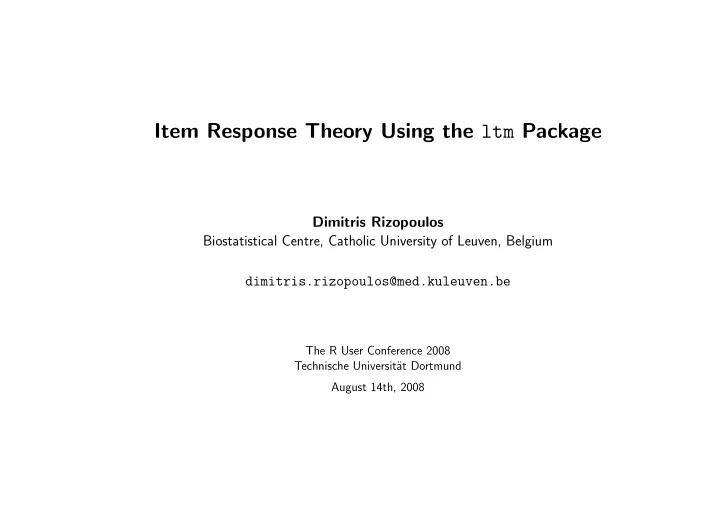

Item Response Theory Using the ltm Package Dimitris Rizopoulos Biostatistical Centre, Catholic University of Leuven, Belgium dimitris.rizopoulos@med.kuleuven.be The R User Conference 2008 Technische Universit¨ at Dortmund August 14th, 2008
1 Let’s Start with An Example • Situation: ⊲ A teacher offers a course on Calculus • Question: ⊲ How can she find out which students have sufficiently understood the material? • Solution: ⊲ Exams – Students need to take a test with questions on Calculus useR! 2008, Dortmund 1/21
1 Let’s Start with Some Questions (cont’d) • What are exams trying to measure: ⇓ The Students’ Ability in Calculus • Features of Ability ⊲ something that is abstract ⊲ something that cannot be directly measured ⊲ something that is latent useR! 2008, Dortmund 2/21
1 Multivariate Data Set • A sample data set (‘1’ correct response; ‘0’ wrong response) Student Item 1 Item 2 Item 3 · · · 1 0 0 0 · · · 2 0 1 1 · · · 3 1 1 1 · · · 4 1 0 1 · · · . . . . . . . . . . . . . . . useR! 2008, Dortmund 3/21
2 Item Characteristic Curve • A pool of items measuring a single latent trait • Basic components ⊲ θ ∈ ( −∞ , ∞ ) : latent ability ⊲ P i ∈ (0 , 1) : probability of responding correctly in item i Item Characteristic Curve: functional relationship between θ and P i useR! 2008, Dortmund 4/21
2 Item Characteristic Curve (cont’d) 1.0 Probability of Correct Response 0.8 0.6 0.4 Item Characteristic Curve 0.2 0.0 −3 −2 −1 0 1 2 3 θ useR! 2008, Dortmund 5/21
2 Item Characteristic Curve & IRT Models 1.0 Probability of Correct Response 0.8 0.6 0.4 exp{ f( θ ) } P ( θ ) = 1 + exp{ f( θ ) } 0.2 0.0 −3 −2 −1 0 1 2 3 θ useR! 2008, Dortmund 6/21
2 Item Characteristic Curve & IRT Models (cont’d) • Two Parameter Logistic Model P i ( θ ) log 1 − P i ( θ ) = α i ( θ − β i ) , i denotes the item • Parameters ⊲ item difficulty parameter: β ⊲ item discrimination parameter: α ⊲ person ability parameter: θ useR! 2008, Dortmund 7/21
2 Special Case: The Rasch Model • proposed by Georg Rasch (Danish mathematician) in 1960 P i ( θ ) log 1 − P i ( θ ) = θ − β i , i denotes the item • Properties and Features ⊲ closed-form sufficient statistics ⊲ restrictive ⇒ α i = 1 for all i ⊲ widely used useR! 2008, Dortmund 8/21
3 IRT Using the ltm Package • ltm package has been designed for user-friendly IRT analyses • Functions for: ⊲ descriptive analyses ⊲ fitting common IRT models ⊲ post-processing of the fitted models ⊲ extra features useR! 2008, Dortmund 9/21
3 Descriptive Analyses >R descript(LSAT) Descriptive statistics for the ’LSAT’ data-set Sample: 5 items and 1000 sample units; 0 missing values Proportions for each level of response: 0 1 logit Item 1 0.076 0.924 2.4980 ... Frequencies of total scores: 0 1 2 3 4 5 Freq 3 20 85 237 357 298 useR! 2008, Dortmund 10/21
Biserial correlation with Total Score: Included Excluded Item 1 0.3618 0.1128 ... Cronbach’s alpha: value All Items 0.2950 Excluding Item 1 0.2754 ... Pairwise Associations: Item i Item j p.value 1 1 5 0.565 ... useR! 2008, Dortmund 11/21
3 Fit IRT Models >R fitRasch <- rasch(LSAT) >R summary(fitRasch) Call: rasch(data = LSAT) Model Summary: log.Lik AIC BIC -2466.938 4945.875 4975.322 Coefficients: value std.err z.vals Dffclt.Item1 -3.6153 0.3266 -11.0680 Dffclt.Item2 -1.3224 0.1422 -9.3009 ... Dscrmn 0.7551 0.0694 10.8757 useR! 2008, Dortmund 12/21
Integration: method: Gauss-Hermite quadrature points: 21 Optimization: Convergence: 0 max(|grad|): 2.9e-05 quasi-Newton: BFGS useR! 2008, Dortmund 13/21
3 Fit IRT Models (cont’d) >R fit2PL <- ltm(LSAT ∼ z1) >R summary(fit2PL) Call: ltm(formula = LSAT ~ z1) Model Summary: log.Lik AIC BIC -2466.653 4953.307 5002.384 Coefficients: value std.err z.vals Dffclt.Item1 -3.3597 0.8669 -3.8754 ... Dscrmn.Item1 0.8254 0.2581 3.1983 ... useR! 2008, Dortmund 14/21
Integration: method: Gauss-Hermite quadrature points: 21 Optimization: Convergence: 0 max(|grad|): 0.024 quasi-Newton: BFGS useR! 2008, Dortmund 15/21
3 Compare Fits with an LRT >R anova(fitRasch, fit2PL) Likelihood Ratio Table AIC BIC log.Lik LRT df p.value fit1 4945.88 4975.32 -2466.94 fit2 4953.31 5002.38 -2466.65 0.57 4 0.967 useR! 2008, Dortmund 16/21
3 Ability Estimates >R factor.scores(fit2PL) Call: ltm(formula = LSAT ~ z1) Scoring Method: Empirical Bayes Factor-Scores for observed response patterns: Item 1 Item 2 Item 3 Item 4 Item 5 Obs Exp z1 se.z1 1 0 0 0 0 0 3 2.277 -1.895 0.795 2 0 0 0 0 1 6 5.861 -1.479 0.796 ... 29 1 1 1 1 0 28 29.127 0.139 0.833 30 1 1 1 1 1 298 296.693 0.606 0.855 useR! 2008, Dortmund 17/21
3 Plot ICCs >R plot(fit2PL, legend = TRUE, cx = "bottomright") Item Characteristic Curves 1.0 Probability of Correct Response 0.8 0.6 0.4 Item 1 0.2 Item 2 Item 3 Item 4 Item 5 0.0 −4 −2 0 2 4 θ useR! 2008, Dortmund 18/21
4 Extra Features of ltm • IRT Models: ⊲ Graded Response Model for polytomous items ⇒ grm() ⊲ Latent Trait Model with 2 latent variables ⇒ ltm() ⊲ Birnbaum’s Three Parameter Model ⇒ tpm() • Goodness-of-Fit: ⊲ Fit on the margins ⇒ margins() ⊲ Bootstrap Pearson χ 2 test ⇒ GoF.rasch() ⊲ Item- and Person-fit statistics ⇒ item.fit() & person.fit() useR! 2008, Dortmund 19/21
4 Extra Features of ltm (cont’d) • Plotting ⊲ Item and Test Information Curves ⊲ Item Person Maps • A lot of other options . . . useR! 2008, Dortmund 20/21
Thank you for your attention! More Information for ltm is available at: http://wiki.r-project.org/rwiki/doku.php?id=packages:cran:ltm useR! 2008, Dortmund 21/21
Recommend
More recommend